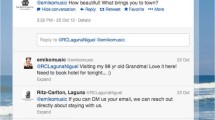Abstract
The rapid growth and popularity of the microblogging service Twitter has been one of the most recent phenomena of the Internet, which opens up opportunities for businesses in general and publishers in particular to do marketing in a dialogue- and consumer-oriented way. This survey analysed UK trade publishers’ use of Twitter with the specific objective of finding out what influence a publisher’s size has on its Twitter adoption, patterns of use and the content of its Tweets. Overall, the results suggest that a publisher’s size primarily affects its general Twitter use, while being less influential regarding its patterns of use and the tweeted content.















Similar content being viewed by others
Notes
In this study size could assume one of the following values: small (sales < £5.257 m in 2009), medium-sized (£5.257 m < sales < £87.915 m in 2009) or large (sales > £87.915 m in 2009).
As a clear outlier with numbers of followers and followees deviating from the means of all other publishers by the factor 156 and 555 respectively, one account had to be ignored in this part of the analysis in order to keep the results unbiased.
According to Twitter, Retweets are Tweets by another user which a followee forwards to his followers; Replies are Tweets posted in reply to another user’s message and begin with the other user’s username attached to an @-symbol [17].
The variety degree regarding titles and authors was calculated by dividing the number of different titles/authors mentioned by the number of Tweets about books/authors. Consequently, a variety degree of 1 was reached when one title/author accompanied one Tweet; the minimum of slightly more than 0 was reached when one title/author accompanied all Tweets mentioning books/authors.
Here publishing-related Tweets not only include miscellaneous publishing-related Tweets, but also Tweets about books, authors, the publishing house and trade events.
References
Abbott C. To Tweet or not to Tweet: twitter basics for publishers and authors: promoting books in 140 characters or less. Publishers Weekly, March 30, 2009. http://www.publishersweekly.com/pw/print/20090330/2722-to-tweet-or-not-to-tweet-twitter-basics-for-publishers-and-authors-.html. Accessed 21 June 2010.
Alexa Internet. Twitter.com. http://www.alexa.com/siteinfo/twitter.com. Accessed 11 July 2010.
Brown R. Public relations and the social web: how to use social Media and Web 2.0 in communications. London: Kogan Page; 2009.
Bryant L. Elements of ‘Enterprise 2.0’. In: Newson A, Houghton D, Patten J, editors. Blogging and other social media: exploiting the technology and protecting the enterprise. Farnham: Gower Publishing; 2009. p. 121–8.
Clapperton G. This is social media: tweet, blog, link and post your way to business success. Chichester: Capstone Publishing; 2009.
Eley B, Tilley S. Online marketing inside out. Collingwood: SitePoint Pty; 2009.
Farmer DK. Twitter’s complex simplicity: how small is the next big thing? Music Ref Serv Q. 2009;12:25–7.
Laudon KC, Traver CG. E-commerce 2010: business, technology, society. Upper Saddle River, NJ: Prentice Hall; 2010.
Newson A, Houghton D, Patten J. Blogging and other social media: exploiting the technology and protecting the enterprise. Farnham: Gower Publishing; 2009.
Quinn J. Twitter’s guide to corporate ‘Tweeting’. The Telegraph, July 24, 2009. http://www.telegraph.co.uk/finance/newsbysector/mediatechnologyandtelecoms/5902415/Twitters-guide-to-corporate-tweeting.html. Accessed 9 July 2010.
Shih CC. The facebook era: tapping online social networks to build better products, reach new audiences, and sell more stuff. Boston, MA: Pearson Education; 2009.
Solis B, Breakenridge D. Putting the public back in public relations: how social media is reinventing the aging business of PR. Upper Saddle River, NJ: FT Press; 2009.
Sterne R. Viral issue: creating your viral loop on Twitter. Publishers Weekly, October 5, 2009. http://www.publishersweekly.com/pw/print/20091005/7760-viral-issue-creating-your-viral-loop-on-twitter-.html. Accessed 21 June 2010.
Strauss J, Frost R. E-marketing. Upper Saddle River, NJ: Pearson Education; 2009.
Teicher CM. Change makers: Twitter: micro-blogging site is quickly gaining publishing followers. Publishers Weekly, May 18, 2009. http://new.publishersweekly.com/pw/print/20090518/5288-change-makers-twitter-.html. Accessed 21 June 2010.
Twitter. About Twitter. http://twitter.com/about. Accessed 9 July 2010.
Twitter. The Twitter glossary. http://support.twitter.com/groups/31-twitter-basics/topics/104-welcome-to-twitter-support/articles/166337-the-twitter-glossary. Accessed 9 July 2010.
Twitter. What are @replies and mentions? http://support.twitter.com/groups/31-twitter-basics/topics/109-tweets-messages/articles/14023-what-are-replies-and-mentions. Accessed 10 July 2010.
Weber L. Marketing on the social web: how digital customer communities build your business. Hoboken, NJ: Wiley; 2009.
Weinberg T. The new community rules: marketing on the social web. Sebastopol: O’Reilly Media; 2009.
Zarrella D. The social media marketing book. Sebastopol: O’Reilly Media; 2010.
Author information
Authors and Affiliations
Corresponding author
Rights and permissions
About this article
Cite this article
Thoring, A. Corporate Tweeting: Analysing the Use of Twitter as a Marketing Tool by UK Trade Publishers. Pub Res Q 27, 141–158 (2011). https://doi.org/10.1007/s12109-011-9214-7
Published:
Issue Date:
DOI: https://doi.org/10.1007/s12109-011-9214-7




